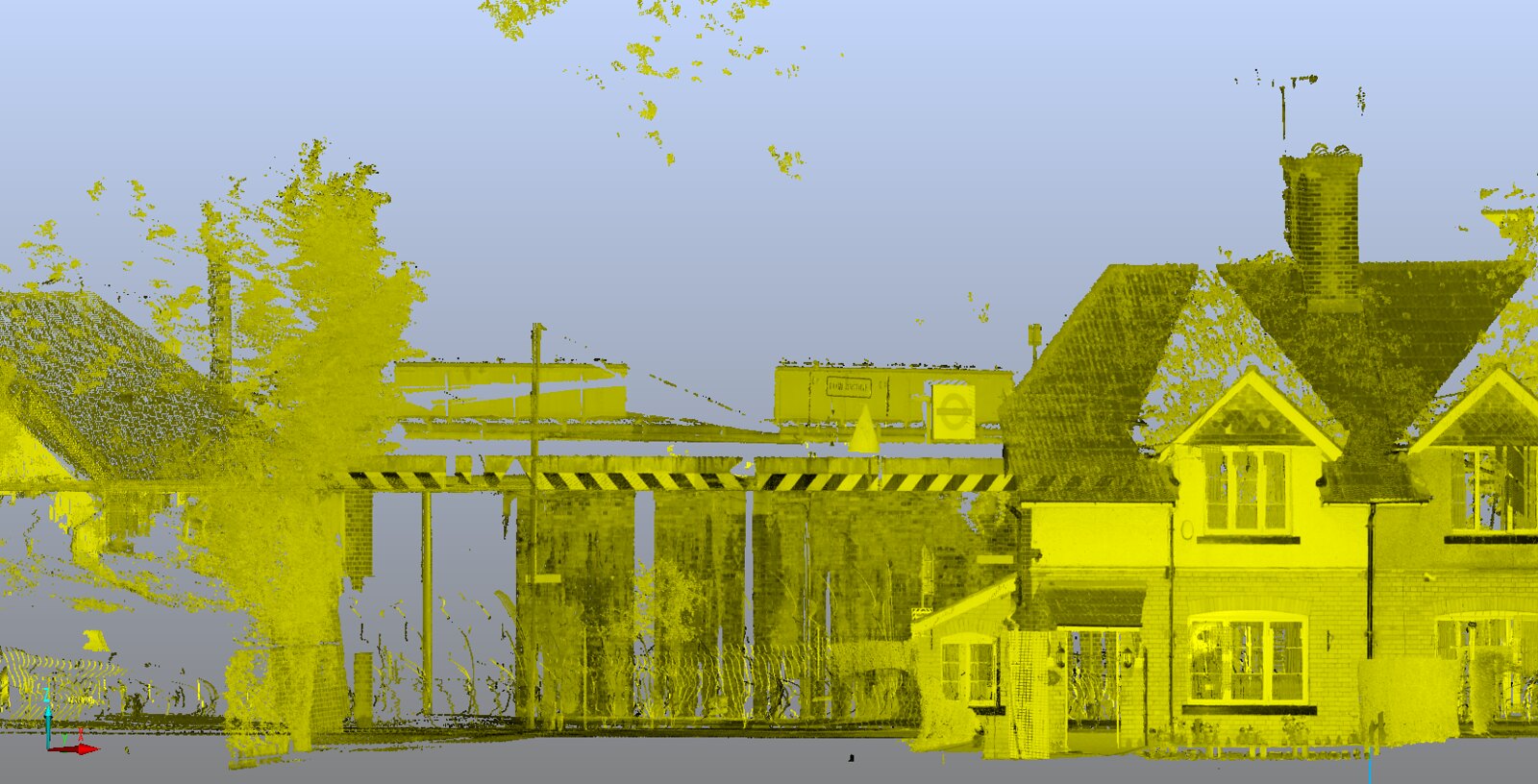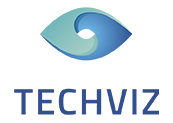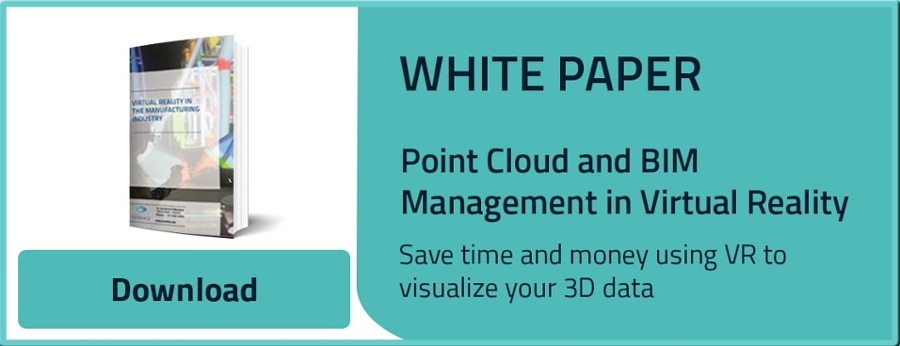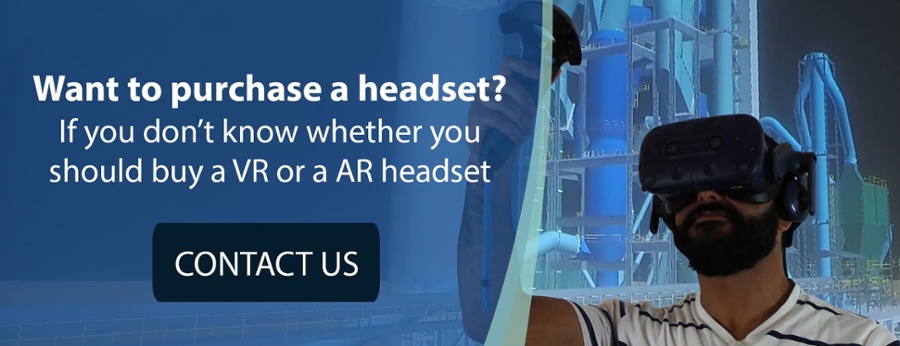Updated July 25, 2022

Generally produced by laser scanning (LiDAR) or photogrammetry, a point cloud is a set of points in space,. Depending on their density, these points help you visualize the external surfaces of objects or environments, as they enable to have a 3D reaslistic representation of an existing environment.. Therefore, they are often used in the construction industry, along with BIM models.
But such sets of data can do a lot more for your industry: 3D scanning technology enables you to capture a digital copy of an object, when creating a CAD model from scratch can be long, costly and complex. Let’s see why point clouds in virtual reality can be a great asset for your industry and how to use it efficiently.
TABLE OF CONTENT
WHY IS POINT CLOUD DATA IMPORTANT?
Point clouds in virtual reality can be useful in many cases. For example, why build a model for an existing object in your factory? In many cases, when you don’t have a CAD model available, creating one from measurements is time-consuming and error-prone compared to generating a point cloud. Besides, you can always use that point cloud as a basis for the 3D model.
Does this mean you should forget about 3D models and only use point cloud data from now on? Absolutely not. They complement one another. Point clouds are often an incomplete representation of a scene, because it only takes the outer layer of objects into account. Engineers working with it can deal with the noise and incompleteness, but software solutions are still under investigation.
The best way to work with point clouds is to visualize them with virtual reality. CAD models provide you with “as-designed” data, whereas point cloud is about “as-is” data. Combining them in the same VR environment enables you to get projected data and compare them with the real data.
If you are interested in how 3D point clouds and CAD models can effectively be combined, check out our ebook about their practical uses in construction industry:
WHAT INDUSTRIES CAN BENEFIT FROM VISUALIZING POINT CLOUDS IN VR?
While it is true that point clouds with vr is mainly used for construction projects (the famous scan-to-BIM), point clouds and virtual reality are also gaining traction in other industries, allowing them to gain a competitive advantage.
1. Architecture
Point clouds make it possible to capture the structures that will be built as well as their surroundings. This is very helpful for renovation works, because architects have to compose with what has already been built. They can navigate the building in VR and have a better understanding on how to start their new 3D model.
For new constructions, point clouds can render the environment outside the building. Then architects can see what view they get from any window using virtual reality.
2. Design and engineering
Engineering companies can use point cloud with vr as a more accurate basis for their analysis, for example to conduct line of sight or shadowing studies.
Also, point clouds give designers and engineers the data about the surface of an object. With VR simulations, these data are an excellent basis to conduct simulations and different analysis, enables to check for design compliance and helps reverse-engineer a finished product.
3. Construction
Traditionally, contractors used video recording or GPS surveys with 2D plans to check their building. But it appears to be that point clouds are much cheaper and information about the status of work is more accurate. It allows construction companies to make realistic decisions on the field, conduct compliance verifications and develop solutions when deviations occur. Visualizing point clouds in VR gives them all the dimensional information they need, even for a large-scale or complex project.

4. Manufacturing
Manufacturers can use point clouds at various stages of their production, from product conception to quality verification. It can also give an “as-is” representation of their workstations and give them an accurate vision of how their factory performs, and if the workstations are well-designed and ergonomic, using VR simulation.
5. Research
Several fields of research have use of point cloud and VR to help in their analysis. For example, archaeology relies on laser scanning surveys to get a 3D representation of an object, monument or landscape so they don’t damage it, and can use VR visualization to replace the object in a historical context.
5 APPLICATIONS OF POINT CLOUDS IN VIRTUAL REALITY
Here are 5 examples on how you can visualize these data to improve your own processes: seize new opportunities by using laser scanning, CAD modelling and 3D software. Visualize complex data with VR.
1. Managing project with “as-is” data
When you have to check the real-life measurements, especially on large-scale projects, you will have to prioritize what to measure, on which criteria and match it with the CAD model. It is a risky method that can lead to errors or miscommunications.
Using point clouds in virtual reality will help you avoid delays by visualizing all the data you need at once. With several versions you even get historical information about your project, enabling you to get more accurate with your costs and planning. VR also enables your teams to collaborate in the same environment, with the same level of information, as if they were all together in the same space around the real product.
2. Inspecting the quality of a finished product
3D laser scanning is faster, more accurate and cheaper than traditional measurements methods. It gives you an accurate image of the surface of an object, and enables you to verify if the final product meets with the quality requirements. Laser scanning is also ideal for checking complex parts or fragile elements. Since it’s not in contact with the product to measure it, you have no risk to alter the product in any way.
Overlapping both sets of data in VR will enable you to inspect your finished products for errors, but also check for deformations over time. For instance, surface inspection is very important in the aircraft industry, because you have to deal with small defects that are invisible for the naked eye. Visualizing the model in VR will enable you to navigate in the full-scale point cloud and model and precisely see where the errors lay, it they can be corrected and what could be done.
3. Fitting a new equipment inside a factory
When you undertake a renovation, or refurbish an existing manufacturing facility, 3D point clouds enable you to assess existing architectural data quickly. Virtual Reality software will allow you to place the CAD model of your new equipment inside your point cloud model to see if it fits. It will also help during the replacement project by indicating to your workers where are the obstacles in the transportation routes for removal and equipment installation. Also, when replacing, some heavy equipment may need a crane for transport and positioning. Visualizing the 3D point cloud in virtual reality will help you:
- Study the installation sequence
- Take into account the difficulties to make the parts of the equipment fit each other in VR
- Anticipate the temporary placement of the equipment delivered and removed
4. Reverse-engineer a finished product
Reverse-engineering is suitable for a large variety of industries, for improving efficiency or design. Making a 3D point cloud out of a final product can also be a competitive tactic. The aim is to take several laser scans to follow through the design-to-manufacturing process in reverse. Analyzing the different steps in VR helps companies create documentation.

This is very useful for building renovation or remodeling, because architects have to compose with existing structures. The 3D point cloud will give the information about the environment outside the building, as well as the “as-built” data.
5. Conduct a specific training
Virtual reality is great for training new people. With 3D point clouds, you can get an exact rendering of your buildings, and tailor your VR training to your needs. This will be most useful for companies who have very specific processes or facilities, and don’t have the use of a CAD model or the resources to make one. For example, nuclear engineers or field technicians can’t access the plant without security clearance, but they still have to train for dangerous scenario. VR training in a point cloud of the plant is the perfect solution to get an accurate, and not too expensive replica, and still be able to transmit the right skills to a (very) specific audience.
If you're interested in learning more about specialized training in Virtual Reality, take a look at our ebook on specialized training in VR:






 Back to Blog
Back to Blog





